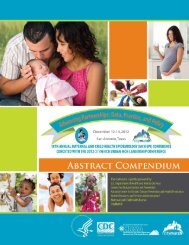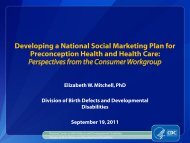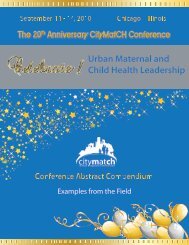Conference Abstract Compendium Examples from the ... - CityMatCH
Conference Abstract Compendium Examples from the ... - CityMatCH
Conference Abstract Compendium Examples from the ... - CityMatCH
You also want an ePaper? Increase the reach of your titles
YUMPU automatically turns print PDFs into web optimized ePapers that Google loves.
2009 <strong>CityMatCH</strong> Urban MCH Leadership <strong>Conference</strong>The process is designed to help stakeholders:• Increase communication and collaboration.• Articulate a shared vision.• Identify current programmatic and policy gaps.• Develop innovative collaborative ideas.• Create state specific action plans.• Build capacity around important issues such as: youth development, funding for collaborative projects,policy and advocacy, disparities, best practices, and engaging hard to reach youth.ACCOMPLISHMENTS/RESULTSThe process has not only led to <strong>the</strong> development of trusting relationships between state health andeducation agencies, and o<strong>the</strong>r stakeholders, but has also led to data sharing, collaborative action planning,reconciliation of differing philosophies, improvement of communications, increased parent andcommunity support for youth access, and development of innovative programs for addressingreproductive and sexual health among adolescents. For example, websites and technology campaigns havedeveloped out of <strong>the</strong> collaborative efforts in states such as Missouri, where <strong>the</strong>y launched an outreachcampaign using social networking sites, and California where <strong>the</strong>y provide youth with access to onlinereproductive health information through community partners.Evaluation Plan:Retrospective pre-post surveys are conducted by an outside evaluator with all participants after <strong>the</strong> events,and after <strong>the</strong> technical assistance follow-up period (9-12 months). In 2010, qualitative interview will beconducted with participants.BARRIERSBarriers to collaboration include time, resources, competing priorities, lack of communication, inability tomeet face-to-face, and silo funding structures.LESSONS LEARNEDNSMs can help streng<strong>the</strong>n communication and collaboration between state departments of education andhealth, and o<strong>the</strong>r stakeholders. Specifically, integrated data sets facilitate <strong>the</strong> development of wellinformedplans required by all MCH programs, new channels of communication create new opportunities,programmatic synergy results <strong>from</strong> a track record of collaboration and networking, and new/streng<strong>the</strong>nedpartnerships provide increased access to staff, expertise and resources o<strong>the</strong>rwise unavailable.67







